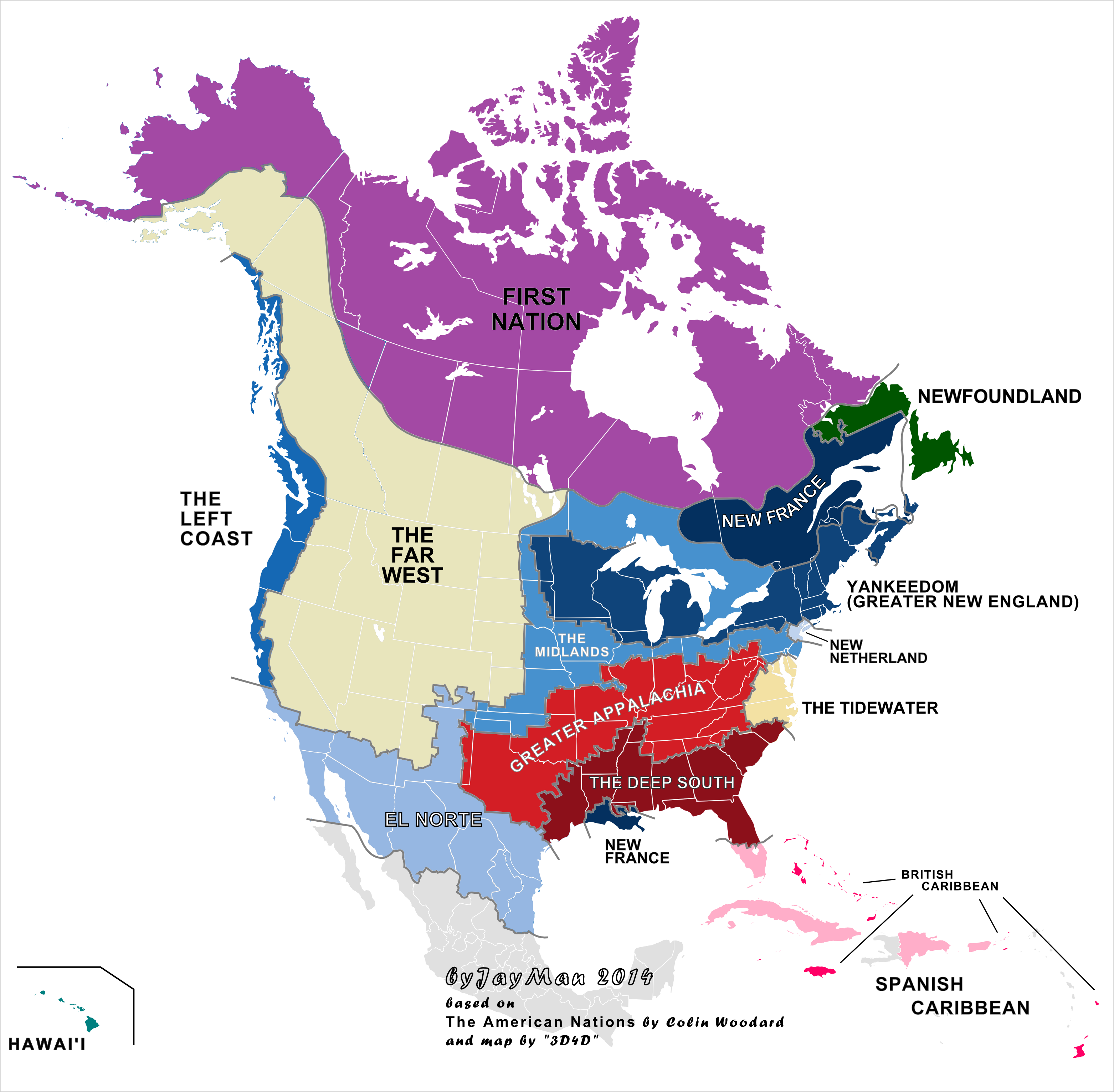
There has been a lot of talk on this board about how the U.S. might be on the brink of breaking up into smaller units. Therefore, it is worthwhile to focus some attention on what might be the natural fault lines -- what are the regional cultures of America?
In American Nations, Colin Woodard identifies eleven:
Of the nations, Woodard explains, "It isn’t that residents of one or another nation all think the same, but rather that they are all embedded within a cultural framework of deep-seated preferences and attitudes – each of which a person may like or hate, but has to deal with nonetheless."
Yankeedom began with the Puritans (Calvinist English settlers) in New England and spread across upper New York, the northern parts of Pennsylvania, Ohio, Indiana, Illinois, and Iowa, into the eastern Dakotas, Michigan, Wisconsin, Minnesota, and the Canadian Maritime. The area values education, communal decision-making and aims at creating a religious utopian communal society to be spread over other regions.
Deep South was settled by former Anglo-American West Indies plantation owners in Charleston, and spread to encompass South Carolina, Georgia, Alabama, Mississippi, Florida, Louisiana, western Tennessee, and the southeastern parts of North Carolina, Arkansas, and Texas. It values old Greco-Roman enlightened, civilized, idle slave society, free-markets and individual freedoms. It has fought centuries with Yankeedom over the dominance of North America, such as in the Civil War and the "culture wars" started by the civil rights movement since the 1960s.
New Netherland, established by Dutch colonists in the 17th century, is now Greater New York City, as well as the lower Hudson Valley, northern New Jersey, western Long Island, and southwestern Connecticut. The area promotes liberal, multicultural values, capitalism and the freedom of the press.
Tidewater was founded by Cavaliers (Royalists during the era of the English Civil War and Stuart Restoration), and consists of Virginia, Maryland, southern Delaware, and northeastern North Carolina. Has cooperated often with Deep South and Greater Appalachia. Together with George Washington, many of the Founding Fathers came from here. Appalachian mountains cut its expansion westwards, and the region is now being overrun by the Midlands.
Greater Appalachia was populated by waves of immigrants that Woodard calls Borderlanders, from the borders of Northern Ireland, northern England, and the Scottish lowlands. Greater Appalachia covers the highlands in the south United States, the southern parts of Ohio, Indiana, and Illinois, the Ozarks of Arkansas and Missouri, eastern Oklahoma, and Texas Hill Country. Its fighting spirit is embodied by figures such as Davy Crockett, Andrew Jackson and Douglas MacArthur.
Midlands, founded by English Quakers followed by the Pennsylvania Dutch, consists of southeast Pennsylvania, southern New Jersey, northern Delaware and Maryland, central Ohio, Indiana and Illinois, northern Missouri, most of Iowa, and the eastern halves of South Dakota, Nebraska, and Kansas, as well has southern Ontario. The border city of Chicago is shared with Yankeedom and St. Louis with Greater Appalachia. Midlands promotes peaceful values and has often been in several elections the great swing-region between Yankeedom and the Southern Nations. According to Woodard it is culturally the most "American" of the nations.
New France began in 1604 with an expedition from France led by Pierre Dugua. It grew to encompass the lower third of Quebec, north and northeast New Brunswick, and southern Louisiana.
El Norte is where the oldest European subculture in the United States is found, from the early Catholic Spanish settlers in the 16th century. Later augmented by Anglo-Americans from Deep South and Greater Appalachia, it includes south and west Texas, southern California and its Imperial Valley, southern Arizona, New Mexico, parts of Colorado, and the Mexican states of Tamaulipas, Nuevo León, Coahuila, Chihuahua, Sonora, and Baja California.
Far West is the interior of the United States and Canada west of the 100th meridian west between El Norte and First Nation. It includes the interiors of California, Oregon, and Washington, much of British Columbia, Alberta, Saskatchewan, Manitoba, and Alaska, part of Yukon and Northwest Territories, the west halves of the Dakotas, Nebraska, and Kansas, as well as Idaho, Montana, Colorado, Utah, and Nevada. The region has been "imperialized" by other nations, such as Yankeedom and Deep South with large mining and infrastructure projects. The Mormon Enclave has been its politically most influential group.
Left Coast was predominantly settled by Yankees from New England, with a huge influx from Greater Appalachia and countries around the world when gold was discovered. It encompasses the land between the Pacific Ocean and the Pacific Coast Ranges from Monterey, California to Juneau, Alaska, containing parts of California, Oregon, Washington, British Columbia, and Alaska. It is an ideological ally with Yankeedom and El Norte.
First Nation, founded by the predominant indigenous peoples in Canada south of the Arctic Circle, consists of much of Yukon, Northwest Territories, Labrador, Nunavut, Greenland, the northern tier of Ontario, Manitoba, Saskatchewan, and Alberta, northwestern British Columbia, and the northern two-thirds of Quebec. It has preserved much better its culture and customs than the Native Americans in the United States.
The alliances
American Nations contends that, on most matters, two major alliances of nations are commonly opposed to each other: the northern alliance of Yankeedom, the New Netherland and the Left Coast, and the southern alliance of the Deep South, Greater Appalachia, and Tidewater. The remaining nations – Midlands, New France, El Norte, and Far West – generally swing individually toward the views of either alliance, depending on the issue. The positions of those "swing" nations determine shifts in the balance of power in the US.[2] For example, the southern alliance is reliably in favor of foreign wars and the northern alliance is generally opposed.[3]
